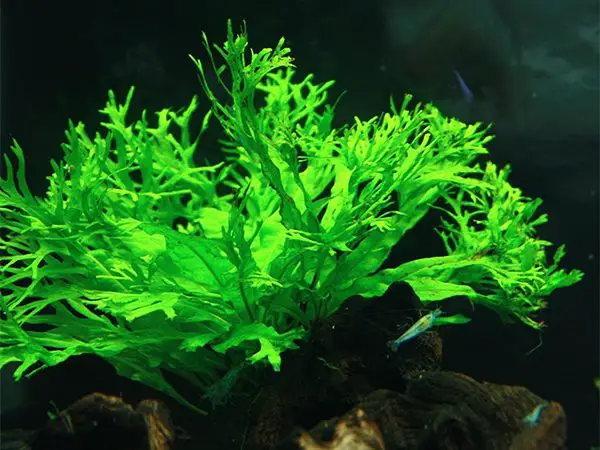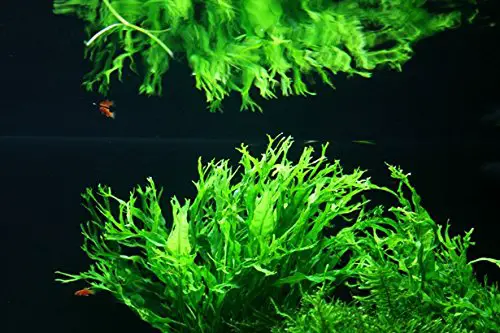Java Fern Windelov (Thai fern) is a home aquarium plant, which is characterized by unpretentious maintenance. In nature, there are many varieties that differ in the shape of the foliage. Aquatic plantations grow slowly, but develop evenly throughout the year. Creeping roots attach to driftwood and rocks, forming wide green shrubs. Subject to the rules of cultivation, they become a decoration of any aquarium or artificial reservoir. Suitable for breeding by both beginners and experienced owners.

Table of Contents
Java Fern Windelov Habitat and Appearance charateristics
The Thai, or Java Fern Windelov (Microsorum pteropus) is a representative of the order of the Centipede. In the wild, it inhabits the coast and water bodies of the countries of Southeast Asia (Java, Malaysia, Thailand, northeastern India). There are varieties with different sizes and shapes of leaves: narrow, lanceolate, needle-like. The most common is the narrow-leaved.
In a tropical environment, an adult plant reaches its largest size – 50-60 cm.The average height of an aquarium specimen is 20-30 cm.
Elongated roots with filamentous branches (rhizoids) cling to tree parts and stones. The bright green foliage has a lanceolate elongated shape. In a favorable microclimate, plants form dense thickets that stretch to the surface. In the process of prolonged growth, small spores appear on the sheets, changing color to a darker one.
The fern grows in water and on land, does not require intense lighting and frequent CO2 application. It gets along with fish eating green plants. Decorates any area of the aquarium.
Java Fern Windelov types and varieties
There are dozens of varieties of Java Fern Windelov in specialized stores. The most popular are 9 varieties.
NARROW-LEAVED MICROSORUM PTEROPUS NARROW
The subspecies has gained popularity among amateurs not so long ago. The length of the roots reaches 15 cm, and the foliage is 18-20 cm. The unpretentious plant is suitable for decorating small containers, narrow leaves adorn intricate driftwood. The price of a copy is 60-80 rubles.
MICROSORUM PTEROPUS UNDULATA
The variety has delicate, wavy, light green foliage. The bush reaches 30-35 cm in height and 25 cm in width. Due to its wide leaves and volumes, it is suitable for aqua design in large aquariums. An exotic variety is rarely found on sale, so the price of a specimen is higher – 200-250 rubles.
PTERYGOID FILIPINO PTEROPUS PHILIPPINE
A bright representative of the fern native to the Philippines. Recently it is in demand among aquarists. Long corrugated leaves grow up to 35-40 cm. The plant is attached with rhizoids to stones or planted in the ground.
Comfortable habitat – salty soft water with a pH level of at least 7 and dim lighting. The growth rate of the specimen is higher than that of other subspecies. Contained in large aquariums. Average price – 175 rubles.
WINDELOV
A feature of the subspecies is the extraordinary shape of the leaf plate, reminiscent of deer antlers. The length of the leaf dissected at the end reaches 12-15 cm, the width of the bush is 20 cm.
Interesting appearance and compactness make it possible to create beautiful compositions in small aquariums. Ease of maintenance and low cost (70-120 rubles) make the plant in demand among beginners and amateurs.
TROPICA PTEROPUS TROPICA
It is considered one of the most hardy varieties. New foliage with even edges tapers as it grows, the plates are serrated. Old leaves fall apart, forming a sprawling bush 35-45 cm wide. Ideal for the background of a large aquarium. The price on the market is 80-100 rubles.
FORK-LEAVED MICROSORUM PTEROPUS FORK LEAF
A decorative and undemanding fern with a soft green color, rarely found in home aquariums. “Horned” leaf plates grow up to 25 cm in length and up to 15-20 cm in width. A dense bush looks interesting anywhere in the aquarium. Contained in water of different hardness and temperature, does not require bright light and fertilizers. The average cost of a sample is 90-100 rubles.
TRUE NARROW-LEAVED REAL NARROW
The variety with the narrowest leaves 2-4 mm wide. Plates are painted in marsh color. Does not require special conditions for keeping. Grown on snags and gravel.
SMALL LEAF
The variety with the smallest foliage – up to 7 cm. Green shoots develop in soft or hard water with a pH level of 4-7 and a water temperature of + 4… + 30 ° C. Suitable for the front of the vessel.
RED MICROSORUM PTEROPUS RED
Young fern leaves are colored red. Over time, they brighten, acquiring a light green hue. The bush reaches a height of 30 cm, in width – 20 cm. The leaf plates are wider than that of a simple Microsorum. Wide bushes are suitable for decorating the back wall of a volumetric aquarium. The price of a copy is 150-180 rubles.
Java Fern Windelov benefits for aquarium
Fern is a natural water purifier in a container. In the process of life, it absorbs both useful and harmful substances. It is recommended to plant the plant in the center line as it covers a large area for cleaning.
Fish spawn in the leaves, and viviparous species hide in dense thickets during childbirth. Defenseless males find shelter from predators.
The Thai fern is suitable for creating interesting underwater compositions.
Java Fern Windelov care and maintenance
Microsorum pteropus does not burden the owners in terms of maintenance and care.

For the normal functioning of aquatic ferns, it is recommended:
- avoid overheating by lighting fixtures;
- prevent a sharp drop in temperature in the tank;
- populate the aquarium with compatible fish species;
- monitor water quality;
- timely cut off withered and spoiled shoots with scissors.
With an acute deficiency of nutrients and insufficient lighting, the plant turns pale and slows down growth until a suitable microclimate is created.
AQUARIUM PARAMETERS
The growing tank is selected according to the height of the tropical plant. Bright greenery is suitable for decorating a deep and voluminous aquarium.
Since the species prefers a calm atmosphere, it is recommended to grow it away from filtering equipment. Fragile shoots do not tolerate constant mechanical stress.
To provide each specimen with a sufficient amount of micro and macro elements, it is necessary to maintain a distance during landing – up to 20 cm from each other. Bushy bushes grow more slowly because their roots are intertwined, which inhibits the development of the entire population.
WATER
The plant loves soft neutral water without sudden temperature fluctuations. A comfortable environment for the growth of most fern species is a tropical climate with a temperature of + 25 … + 30 ° C. In cool water, the culture slows down development. A suitable hardness value is 0-6 ° dH, the acidity level (pH) is 4-6. It is recommended to replace 15-20% of the total water volume 1-2 times a month.
LIGHTING
Most varieties of Microsorum prefer dim artificial or natural diffused lighting. The plant slows down its growth with prolonged darkening. The recommended daylight hours are 10-12 hours. It is recommended to use incandescent lamps or fluorescent lamps with white dim light as lighting devices. The power is selected in accordance with the volume of the aquarium at the rate of 0.3-0.5 W per 1 liter.
An overabundance of illumination leads to the fact that the foliage becomes brown and transparent. When burned, the plates turn yellow and fall off. It is necessary to diffuse sunlight and reduce the intensity of artificial light.
Planting substact
Many varieties of Javanese fern do not require soil and do not need additional fertilizers (fine-grained silted sand is sufficient). Due to the undeveloped rhizome, which spreads over the substrate, the plant is attached to decorative elements, driftwood or coarse gravel.
The following means are used for fastening:
- glue;
- fishing line;
- thin silk thread;
- harness.
After weighting, the bush easily moves to any corner of the tank.
Fertilizers
The intensive development and growth of representatives of Microsorum pteropus requires regular fertilization (at least 2 times a month). Fern receives all nutrients from water. For enrichment, liquid nitrogen fertilizer urea (urea) is used, which is applied at the rate of 10-12 granules per 100 liters. The supply of CO2 and universal mineral compositions when changing the water in the tank has a beneficial effect on the development and color saturation.
Due to the lack of a developed root system, feeding in the form of sub-root tablets will not work.
Java Fern Windelov propagation
Reproduction of tropical ferns occurs in a vegetative way. Daughters with 2-3 leaves are separated from the old bush. Then they are tied to a wooden lath or pebble at a short distance from each other for rooting.
The second breeding method is the formation of young shoots on the leaves of an adult plant. After blackening and dying off of the mother sheet, the layers are separated and remain floating on the surface. After the formation of long floating roots, the seedlings are prepared for planting. To create a dense carpet, a mesh is used to which the roots are densely tied. The growth rate is 2-3 weeks.
The pterygoid and narrow-leaved fern does not tolerate frequent transplants and frequent blowing.
Java Fern Windelov compatible with other inhabitants in the aquarium
The main advantage of the Microsorum family is the specific structure of the foliage (it is believed that the shoots are tough and bitter in taste). This discourages herbivorous species of fish and turtles from eating the fern, so they are suitable for the neighborhood.
The plant gets along well with cichlids, guppies, scalars, apistograms, swordtails and anubias, who love to feast on greens.
It is not recommended to populate fish digging soil into the tank. They easily damage thin roots, slowly destroying the bush.
These varieties include:
- gold fish;
- catfish;
- agamixis;
- corridor, etc.
Observing the main technical indicators and simple growing rules, the aquarist gets lush bushy thickets and bright decor.